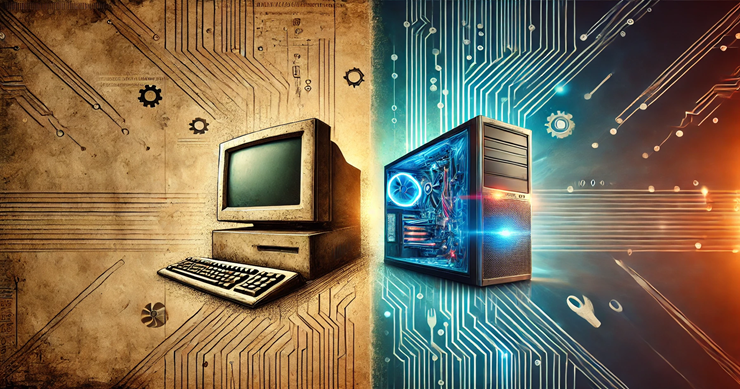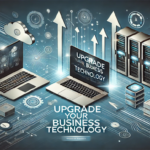Understanding the Signs, Solutions, and Future Prospects for Your Aging Computer
Introduction
Computers are the lifeblood of modern society. Whether you’re writing emails, managing projects, streaming videos, or playing games, these machines keep us connected, productive, and entertained. But as with any technology, they age. The moment your computer begins to falter—freezing during boot-up, slowing to a crawl when multitasking, or outright refusing to turn on—you might ask yourself, “Is my computer dead? Is it time for a new PC?”
These are critical questions. Knowing when to repair, upgrade, or replace your computer can save you money, time, and frustration. This comprehensive guide will walk you through the telltale signs of a failing computer, explore cost-effective solutions, and help you decide when it’s time to let go and invest in a new machine.
History and Background
The journey of personal computing began with bulky, expensive systems designed for a niche market. By the early 1980s, computers like the IBM PC and Apple Macintosh brought technology into homes and offices, laying the groundwork for the personal computing revolution.
Over the decades, the evolution of processors, memory, and storage has exponentially increased the capabilities of computers. However, this rapid progress has also accelerated the obsolescence of older models. For example:
- 1980s-1990s: Early systems used magnetic storage (floppy disks, HDDs) and simple user interfaces. Upgrades often meant replacing individual components like RAM or hard drives.
- 2000s: The introduction of solid-state drives (SSDs) and multi-core processors ushered in faster and more reliable systems.
- 2010s-2020s: Cloud computing, AI integration, and high-speed connectivity raised performance expectations, leaving older systems struggling to keep up.
Today, understanding your computer’s lifecycle is more important than ever. Most PCs have a functional lifespan of 3-8 years, depending on how they’re used, maintained, and upgraded.
Core Concepts and Principles
To decide whether your computer is “dead,” you need to evaluate several core factors:
1. Hardware Degradation
Hardware components wear out over time. Here are the common culprits:
-
-
- Hard Drives (HDDs): Traditional spinning-disk drives can fail after 3-5 years due to mechanical wear. Symptoms include frequent crashes or clicking noises.
- Solid-State Drives (SSDs): While more durable, SSDs have a finite number of write cycles, typically lasting 5-10 years.
- Central Processing Unit (CPU): CPUs rarely fail outright but may become obsolete as software demands increase.
- RAM (Memory): Insufficient or failing RAM can cause frequent freezes and crashes.
-
2. Software Obsolescence
Operating systems and applications evolve to meet modern security and functionality needs. Older systems may lack the resources to run the latest software or receive essential updates, leaving them vulnerable.
3. Diagnostic Tools
Running diagnostics can help pinpoint issues. Tools like CrystalDiskInfo (for drives) and MemTest86 (for RAM) can reveal whether components are failing or just overloaded.
4. Compatibility
Advancements in USB standards, Wi-Fi, and display technologies may render older computers incompatible with new peripherals and networks.
Current Trends and Developments
1. Modern Storage Solutions
SSDs are replacing HDDs as the default storage medium. Benefits include faster boot times, improved durability, and quieter operation. NVMe drives, a newer SSD technology, offer even higher speeds.
2. Cloud Computing
Many businesses and individuals are moving data to the cloud, reducing the need for high-capacity local storage. This trend can extend the life of older computers by offloading resource-heavy tasks.
3. Modular and Sustainable Design
Manufacturers like Framework and Dell are exploring modular laptops, which allow users to upgrade or replace individual parts, promoting longevity and reducing electronic waste.
4. Enhanced Security Features
Windows 11 requires TPM 2.0, a hardware-based security feature, which excludes many older computers from compatibility. This shift emphasizes the importance of keeping hardware updated for security reasons.
5. Lightweight Operating Systems
For users with aging hardware, lightweight OS options like Linux distributions (e.g., Ubuntu or Mint) can breathe new life into old machines by reducing resource requirements.
Applications and Implications
An aging or malfunctioning computer can significantly impact various aspects of life:
1. Home and Personal Use
-
- Impact: Slow computers can hinder basic tasks like web browsing, streaming, and document editing.
- Solution: Upgrades like adding RAM or switching to an SSD can dramatically improve performance for everyday activities.
2. Professional Productivity
-
- Impact: A slow or unreliable computer can lead to missed deadlines and decreased efficiency.
- Solution: Evaluate the cost of upgrading versus replacing, especially if your job relies heavily on computing power.
3. Security Risks
-
- Impact: Unsupported systems are prime targets for cyberattacks.
- Solution: Ensure your computer meets minimum requirements for the latest operating system or consider upgrading to a newer model.
4. Environmental Considerations
-
- Impact: Disposing of old electronics contributes to e-waste.
- Solution: Explore recycling programs or donate usable parts to minimize environmental impact.
Challenges and Solutions
1. Cost of Upgrades
-
- Challenge: Upgrading components can sometimes approach the cost of a new system.
- Solution: Perform a cost-benefit analysis. For example, upgrading from an HDD to an SSD can significantly improve performance for as little as $50-$100.
2. Diagnosing Problems
-
- Challenge: It can be difficult to determine whether issues stem from hardware, software, or user habits.
- Solution: Use diagnostic tools and consult professional technicians for accurate assessments.
3. Balancing Performance Needs
-
- Challenge: It’s easy to overspend on features you don’t need.
- Solution: Consider your primary tasks (e.g., gaming, video editing, browsing) and choose upgrades or new systems accordingly.
4. Data Migration
-
- Challenge: Transferring data from an old computer can be time-consuming.
- Solution: Use external hard drives, cloud storage, or data migration software to streamline the process.
Future Prospects
The future of computing promises more durable, powerful, and environmentally friendly devices:
1. Artificial Intelligence Integration
AI-driven diagnostics may soon enable computers to self-diagnose and optimize performance, extending their useful life.
2. Cloud-First Devices
Chromebooks and similar devices prioritize cloud computing, reducing the need for high-performance local hardware.
3. Advances in Materials
Graphene and other advanced materials could revolutionize components like processors and batteries, making them faster and longer-lasting.
4. Circular Economy
The tech industry is embracing sustainable practices, including refurbishing and recycling programs to reduce e-waste.
Case Studies and Examples
Case Study 1: Upgrading an Aging Laptop
A 2015 laptop with a traditional hard drive and 4GB of RAM struggled with slow performance. Upgrading to an SSD and 8GB of RAM for under $200 resulted in a 300% performance boost, extending its life by several years.
Case Study 2: Modular Laptop by Framework
Framework’s modular laptop allowed a user to upgrade their CPU and RAM without replacing the entire system, saving money and reducing waste.
Case Study 3: Lightweight Linux Saves a Desktop
A decade-old desktop unable to run modern Windows was revived with Ubuntu, allowing it to perform basic tasks like web browsing and document editing.
Conclusion
Deciding whether your computer is “dead” or simply in need of an upgrade requires a thoughtful evaluation of its hardware, software, and your specific needs. Understanding the signs of hardware failure, leveraging diagnostic tools, and exploring upgrade options can save you money and extend your system’s life. However, if your computer no longer meets your performance or security requirements, investing in a new PC may be the most practical choice.
Key Takeaways:
- Diagnose issues early using hardware tests and software updates.
- Evaluate the cost-effectiveness of upgrades before replacing your computer.
- Consider future-proofing by investing in modular or sustainable systems.
Call to Action: Stay proactive about your computer’s health by performing regular maintenance, exploring upgrade options, and consulting resources like PC Runs for guidance. For more tips, subscribe to our newsletter, share this article, and check out related content on keeping your technology running smoothly.





